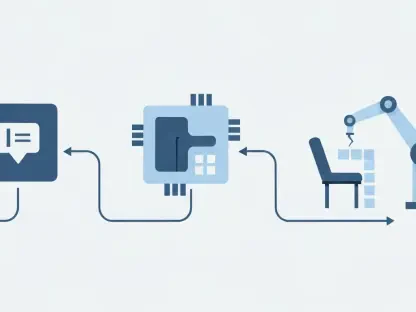The technological landscape has witnessed monumental changes as organizations continually seek innovative ways to enhance their operational efficiency. One of the most notable transformations in recent years has been brought about by Palantir Technologies Inc. The company, known for its cutting-edge software solutions, has redefined its IT landscape by significantly trimming its IT workforce from over 200 to fewer than 80 employees. This drastic reduction was made possible through the strategic deployment of artificial intelligence (AI) and a federated organizational model that integrates IT capabilities directly into business units. Chief Information Officer (CIO) Jim Siders shared insights on this revolutionary approach during an interview on the Technovation podcast, crediting an MIT professor’s inspiration to abolish traditional IT organizations.
Harnessing AI through the Foundry Platform
Central to Palantir’s transformation has been the deployment of its AI-powered Foundry platform. Foundry stands out by enabling the seamless integration, analysis, and execution on massive datasets, thus automating numerous traditional IT functions that previously relied on substantial human intervention. The platform’s ability to handle vast quantities of data, streamline processes, and facilitate rapid decision-making has allowed Palantir to maintain exceptional IT performance while operating with a leaner team. This advancement in AI technology not only enhances the robustness and responsiveness of IT systems but also ensures that operational challenges are addressed swiftly and effectively.
Moreover, the cost benefits derived from leveraging AI have been noteworthy. By reducing the need for human labor in many routine IT tasks, Palantir has significantly cut down operational expenses. The shift to AI-driven operations has demonstrated that small, agile teams can achieve remarkable outcomes, previously thought to be the domain of large IT departments. This goes beyond mere cost-cutting; it represents a fundamental shift in how IT infrastructure is managed and optimized for better efficiency.
A Paradigm Shift in IT Organization
Palantir’s restructured IT organization relies heavily on a federated model, an agile approach that aligns IT support directly with business objectives. Under this model, IT capabilities are embedded within individual business units, thereby enhancing flexibility and responsiveness. This decentralized approach ensures that each unit can tailor its technological resources to suit specific needs, leading to more targeted and effective solutions. The elimination of a centralized IT department fosters faster decision-making and improved agility in response to technological disruptions.
This federated approach also exemplifies how reducing the dependence on large IT departments can result in a more streamlined and efficient organization. By embedding IT within business units, Palantir has effectively aligned technological support with business imperatives, enhancing the cohesion between technology and operational goals. The realignment has further translated into quicker allocation of resources and enhanced capacity to adapt to evolving business demands.
Commercial Growth and Organizational Efficiency
Palantir’s strategic initiatives have not only reshaped its IT infrastructure but have also fueled its commercial growth. The company has witnessed rapid expansion, with annual revenues now approaching $4 billion. The AI-driven model has been instrumental in achieving these impressive financial milestones. The fusion of AI with the federated IT model exemplifies how modern technology can considerably bolster an organization’s efficiency and competitiveness.
The AI-powered strategy developed by Palantir also sets a potential benchmark for other enterprises yearning to optimize their technological framework. It offers a model for integrating advanced technology to achieve operational excellence with a lean system. The emphasis on AI underscores a broader industry trend where automation and machine learning are increasingly seen as critical resources for enhancing productivity and reducing operational costs. As AI technology continues to develop, it is likely that Palantir’s approach will be mirrored by other organizations looking to streamline their IT functions while retaining, or even enhancing, their performance standards.
The Future of IT in the AI Era
As more organizations observe Palantir’s success, the adoption of AI and a federated model may become a norm rather than an exception. Palantir’s methodology highlights that innovation lies in the integration of cutting-edge technology with forward-thinking organizational strategies. By reducing headcount and embedding IT functions within business units, companies can not only cut costs but also foster a more adaptable and responsive operational framework. As AI continues to advance, its applications in streamlining business processes and reducing redundancy are expected to expand, offering new avenues for efficiency and growth.
The impact of Palantir’s innovative approach is likely to extend beyond just IT. It serves as an example of how modern enterprises can leverage AI to redesign their organizational structures fundamentally. The dual focus on reducing staff numbers and enhancing efficiency demonstrates that the technological revolution in IT is not about replacing human roles entirely but about redeploying human resources towards more strategic, value-added activities.
A Blueprint for Technological Optimization
Key to Palantir’s evolution has been the rollout of its AI-driven Foundry platform. Foundry excels in integrating, analyzing, and executing vast datasets, effectively automating many traditional IT tasks that once relied heavily on human intervention. This capability to manage extensive data, streamline operations, and aid quick decision-making has enabled Palantir to sustain outstanding IT performance with a leaner workforce. This leap in AI technology not only boosts the resilience and responsiveness of IT systems but also ensures that operational issues are quickly and efficiently addressed.
Furthermore, the cost savings from utilizing AI have been substantial. By decreasing the reliance on human workers for routine IT tasks, Palantir has notably slashed operational costs. The transition to AI-centered operations has shown that small, nimble teams can achieve exceptional results, once thought possible only for large IT departments. This shift transcends mere cost reduction; it signifies a fundamental change in the management and optimization of IT infrastructure for enhanced efficiency.









